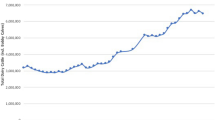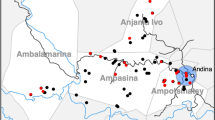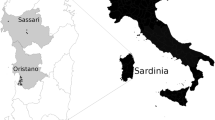Abstract
The public health risks associated with dairy farming intensification are an emerging concern. We examine the association between dairy cattle density and cryptosporidiosis risk in children <5 years old in New Zealand from 1997 to 2008, a period of rapid intensification of the dairy industry. Multi-level Poisson regression was used to model reported cryptosporidiosis (N = 3869 cases) incidence in relation to dairy cattle densities across urban and rural areas separately, after controlling for microbiological quality of public drinking water supplies and neighbourhood socio-economic factors using the Census Area Unit of residence. Within urban areas, the risk of cryptosporidiosis in children less than 5 years old was significantly, positively associated with medium and high dairy cattle density IRR 1.3 (95% CI 1.2, 1.5) and 1.5 (95% CI 1.2, 1.9) respectively, when compared to areas with no dairy cattle. Within rural areas, the incidence risk of cryptosporidiosis in children less than 5 years old were significantly, positively associated with medium and high dairy cattle density: IRR 1.7 (95% CI 1.3, 2.3) and 2.0 (95% CI 1.5, 2.8) respectively, when compared to areas with no dairy cattle. These results have public health implications for children living on and in proximity to intensively stocked dairy cattle farms.


Similar content being viewed by others
References
Abeywardena H, Jex AR, et al. (2012) Genetic characterisation of Cryptosporidium and Giardia from dairy calves: Discovery of species/genotypes consistent with those found in humans. Infection, Genetics and Evolution 12(8): 1984–1993
Mawly Al J, Grinberg A, et al. (2015) Cross sectional study of prevalence, genetic diversity and zoonotic potential of Cryptosporidium parvum cycling in New Zealand dairy farms. Parasites and Vectors 8(1): 240
Arshad MM, Wilkins MJ, et al (2007) A registry-based study on the association between human salmonellosis and routinely collected parameters in Michigan, 1995-2001. Foodborne Pathogens and Disease 4(1): 16–25
Baker MG, Sneyd E, et al. (2007) Is the major increase in notified campylobacteriosis in New Zealand real? Epidemiology and Infection 135(01): 163–170
Bouwman L, Goldewijk KK, et al. (2011) Exploring global changes in nitrogen and phosphorus cycles in agriculture induced by livestock production over the 1900–2050 period. Proceedings of the National Academy of Sciences. doi:10.1073/pnas.1012878108
Britton E, Hales S, et al. (2010) The impact of climate variability and change on cryptosporidiosis and giardiasis rates in New Zealand. Journal of Water and Health 8(3): 561–571
Brock A (2011) The effect of climate variation on infectious diseases in humans in New Zealand. Masters in Veterinary Studies, Massey University.
Burnet JB, Penny C, et al. (2014) Spatial and temporal distribution of Cryptosporidium and Giardia in a drinking water resource: Implications for monitoring and risk assessment. Science of the Total Environment 472: 1023–1035
Close M, Dann R, et al. (2008) Microbial groundwater quality and its health implications for a border-strip irrigated dairy farm catchment, South Island, New Zealand. Journal of Water and Health 6(1): 83–98
Close M, Noonan M, et al. (2010) Microbial Transport from Dairying under Two Spray-Irrigation Systems in Canterbury, New Zealand. Journal of Environmental Quality 39(3): 824–833
Crump JA, Murdoch DR, et al. (2001) Emerging infectious diseases in an island ecosystem: the New Zealand perspective. Emerging Infectious Diseases 7(5): 767–772
Davies-Colley R, Lydiard E, et al. (2008) Stormflow-dominated loads of faecal pollution from an intensively dairy-farmed catchment. Water Science and Technology 57(10): 1519–1523
Davies-Colley RJ, Nagels JW, et al. (2004) Water quality impact of a dairy cow herd crossing a stream. New Zealand Journal of Marine and Freshwater Research 38(4): 569–576
Derraik JGB, Slaney D (2007) Anthropogenic environmental change, mosquito-borne diseases and human health in New Zealand. Ecohealth 4(1): 72–81
Duncan C, Jones K, et al. (1996) Health-related behaviour in context: a multilevel modelling approach. Social Science & Medicine 42(6): 817–830
Duncanson M, Russell N, et al. (2000) Rates of notified cryptosporidiosis and quality of drinking water supplies in Aotearoa, New Zealand. Water Research 34(15): 3804–3812
Grinberg A, Pomroy WE, et al. (2011) Retrospective cohort study of an outbreak of cryptosporidiosis caused by a rare Cryptosporidium parvum subgenotype. Epidemiology & Infection 139(Special Issue 10): 1542–1550
Hunter PR, Thompson RCA (2005) The zoonotic transmission of Giardia and Cryptosporidium. International Journal for Parasitology 35(11–12): 1181–1190
Jagai J, Griffiths J, et al. (2010) Patterns of protozoan infections: Spatiotemporal associations with cattle density. EcoHealth 7(1): 33–46
Jones BA, Grace D, et al. (2013) Zoonosis emergence linked to agricultural intensification and environmental change. Proceedings of the National Academy of Sciences 110(21): 8399–8404
Jones KE, Patel NG, et al. (2008) Global trends in emerging infectious diseases. Nature 451(7181): 990–993
Kotloff KL, Blackwelder WC, et al. (2012) The Global Enteric Multicenter Study (GEMS) of diarrheal disease in infants and young children in developing countries: epidemiologic and clinical methods of the case/control study. Clin Infect Dis 55 Suppl 4: S232–245
Lal A (2014) Evaluating the Environmental and Social Determinants of Enteric Disease in New Zealand. Doctor of Philosophy, Univesity of Otago.
Learmonth J, Ionas G, et al. (2001) Seasonal shift in Cryptosporidium parvum transmission cycles in New Zealand. Journal of Eukaryotic Microbiology 48(Suppl): 34S–35S
Learmonth J, Ionas G, et al. (2003) Identification and genetic characterisation of Giardia and Cryptosporidium strains in humans and dairy cattle in the Waikato Region of New Zealand. Water Science and Technology 47(3): 21–26
MacLeod CJ, Moller H (2006) Intensification and diversification of New Zealand agriculture since 1960: An evaluation of current indicators of land use change. Agriculture, Ecosystems & Environment 115(1–4): 201–218
McCarthy ND, Gillespie IA, et al. (2012) Molecular epidemiology of human Campylobacter jejuni shows association between seasonal and international patterns of disease. Epidemiology and Infection 140(12): 2247–2255
Miller WA, Lewis DJ, et al. (2007) Climate and on-farm risk factors associated with giardia duodenalis cysts in storm runoff from california coastal dairiesv. Applied and Environmental Microbiology 73(21): 6972–6979
Moore D, Black M, et al. (2010) Cost benefit analysis of raising the quality of New Zealand networked drinking water., CH2M Beca Limited: 103
Murray KA, Allen T, et al. (2016) Emerging Viral Zoonoses from Wildlife Associated with Animal-Based Food Systems: Risks and Opportunities. In: Food Safety Risks from Wildlife, New York: Springer, pp 31–57
Odoi A, Martin S, et al. (2004) Investigation of clusters of giardiasis using GIS and a spatial scan statistic. International Journal of Health Geographics 3(1): 1–11
Pollock KGJ, Ternent HE, et al. (2009) Spatial and temporal epidemiology of sporadic human cryptosporidiosis in Scotland. Zoonoses and Public Health 57(7–8): 487–492
Salmond C, Crampton P, et al. (2006) NZDep2006 Index of deprivation user’s manual- research report, Wellington School of Medicine and Health Sciences
Sarkar R, Kattula D, et al. (2014) Risk factors for cryptosporidiosis among children in a semi urban slum in Southern India: a nested case-control study. The American Journal of Tropical Medicine and Hygiene 91(6): 1128–1137
Snel SJ, Baker MG, et al. (2009) A tale of two parasites: the comparative epidemiology of cryptosporidiosis and giardiasis. Epidemiology and Infection 137(11): 1641–1650
Snel SJ, MG Baker, et al. (2009) The epidemiology of cryptosporidiosis in New Zealand. New Zealand Medical Journal 122: 1290
StataCorp (2013) Stata Statistical Software: Release 13, College Station, Texas: StataCorp LP
Statistics New Zealand (2012) Agricultural Production Statistics: June 2012 (final)—Media Release. Retrieved 30 July, 2013, from http://www.stats.govt.nz/browse_for_stats/industry_sectors/agriculture-horticulture-forestry/AgriculturalProduction_final_MRJun12final.aspx
Statistics New Zealand (2012) New Zealand: An Urban/Rural Profile Update. Retrieved 30 July, 2013, from http://www.stats.govt.nz/browse_for_stats/people_and_communities/Geographic-areas/urban-rural-profile-update.aspx
Statistics New Zealand, A. (2010) Historical Population Estimates. Wellington, Government of New Zealand
Stefanogiannis N, McLean M, et al. (2001) Outbreak of cryptosporidiosis linked with a farm event. New Zealand Medical Journal 114(1144): 519–521
Taylor LH, Latham SM, et al. (2001) Risk factors for human disease emergence. Philosophical Transactions of the Royal Society B: Biological Sciences 356(1411): 983–989
Thorburn D (2011) Ruminant density, Verocytotoxigenic Escherichia Coli and cryptosporidiosis in New Zealand: Descriptive and ecological analyses, Dunedin: University of Otago
Wendt A, Kreienbrock L, et al. (2016) Joint use of Disparate Data for the Surveillance of Zoonoses: A Feasibility Study for a One Health Approach in Germany. Zoonoses and Public Health
Yoder JS, Wallace RM, et al. (2012) Cryptosporidiosis surveillance—United States, 2009–2010. Morbidity and mortality weekly report. Surveillance summaries (Washington, D.C.: 2002) 61(5): 1–12
Zambrano LD, Levy K, et al. (2014) Human diarrhea infections associated with domestic animal husbandry: a systematic review and meta-analysis. Transactions of the Royal Society of Tropical Medicine and Hygiene 108(6): 313–325
Zinsstag J, Roth F, et al. (2005) A model of animal–human brucellosis transmission in Mongolia. Preventive Veterinary Medicine 69(1): 77–95
Acknowledgment
This study was possible through A Lal’s salaried position at the Australian National University.
Author information
Authors and Affiliations
Corresponding author
Ethics declarations
Conflict of Interest
Author Simon Hales is a review editor for the journal.
Research Involving Human Rights
The authors assert that all the procedures performed in studies involving human participants were in accordance with the ethical standards of the institutional and/or national research committee and with the 1964 Helsinki Declaration and its later amendments or comparable ethical standards.
Electronic Supplementary Material
Below is the link to the electronic supplementary material.
Rights and permissions
About this article
Cite this article
Lal, A., Dobbins, T., Bagheri, N. et al. Cryptosporidiosis Risk in New Zealand Children Under 5 Years Old is Greatest in Areas with High Dairy Cattle Densities. EcoHealth 13, 652–660 (2016). https://doi.org/10.1007/s10393-016-1187-8
Received:
Revised:
Accepted:
Published:
Issue Date:
DOI: https://doi.org/10.1007/s10393-016-1187-8




